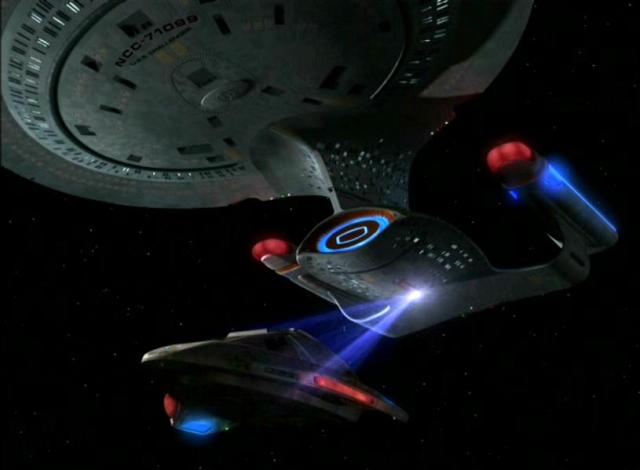
Science Fiction or Fact: Will Tractor Beams Ever Become Reality?

In this weekly series, Life's Little Mysteries rates the plausibility of popular science fiction concepts.
Got a derelict spaceship you need to tow back to star base? Or maybe you're trying to prevent an enemy vessel from escaping? No problem: fire up the tractor beam.
This jack-of-all-trades tool ranks as a science fiction staple right alongside lasers and faster-than-light travel. An invisible tractor beam on the Death Star hauled in the Millennium Falcon in the original "Star Wars" flick, while a shimmering ray — which doubled as a repulsing beam — saved the crew's bacon multiple times on "Star Trek."
In sci-fi, tractor beams often consist of exotic-sounding particles and energies. In our day and age, using regular ol' light to hold and manipulate objects tractor beam-style is already a reality, albeit on very tiny scales.
Biologists, for example, have used "optical tweezers" to study cells, DNA and other small bits since the late 1980s. "Optical trapping has been around a long time," said Paul Stysley, a laser engineer at NASA's Goddard Space Flight Center.
Stysley's organization, among others, would like to see tractor beam-like technologies graduate to bigger tasks. Light could be used, NASA researchers think, to collect large dust particles on Mars or from the tail of a comet with better results than typical contact-based methods.
In theory, continued improvement could someday lead to tractor beams not all that dissimilar to that deployed on the Starship Enterprise. "There seems to be no basic reason why you couldn't have a tractor beam," said Sidney Perkowitz, a physicist at Emory University in Atlanta, Ga.
Sign up for the Live Science daily newsletter now
Get the world’s most fascinating discoveries delivered straight to your inbox.
Push . . .
Light lacks the obvious grappling ability of, say, a sharp hook. Yet the photons that comprise light can be used to attract or repulse. [Science Fiction or Fact: Is Faster-than-Light-Travel Possible?]
Photons possess momentum, and so when they strike an object and lose momentum, a small amount of force is applied, Perkowitz explained. "You can think of light as being like little pellets," he said.
The gentle push of photons, known as radiation pressure, was demonstrated in space recently by a "solar sail" experiment. Sunlight hitting a sheet of mirror-like material — like wind in earthly sails — propelled the Japanese IKAROS spacecraft to speeds greater than 200 mph in a mission starting in 2010.
. . . and pull
Pulling with light, however, is not as simple, but can be done by harnessing photons' electromagnetic properties and various clever ways of shining laser beams.
Three promising tractor beam methods stand out, according to NASA, and might see service on future space probes. "We believe these technologies could be ready in 10 years," Stysley said. [5 Ways the World Will Change Radically this Century]
One concept involves so-called Bessel beams. Rather than the disk of light one sees on a wall from a regular laser beam, Bessel beams look like an archery target, with rings surrounding a central spot. Theoretical work suggests that electrical and magnetic fields in the path of Bessel beams could conspire to "create a force opposite the propagation of the laser beam itself," Stysley said. In simpler words: come to papa.
A second technique follows the optical tweezers approach used in biology. Two overlapping beams of light, when shone on an object, surround it in a ring with a less-illuminated central zone. The beams warm the air around the particle, and by switching the intensity of the beams back and forth, the particle can be pulled down the central corridor. (This optical conveyor belt method cannot work in the vacuum of space, though.)
The third method is based on solenoid beams. The intensity of such a beam spikes in a spiral along its length, giving the ray a nice, science fiction-esque swirl of brightness, Stysley noted. The peaks in intensity can attract matter, and depending on the angle or intensity of the beam, an operator can control whether a target inches forward or backward.
Readying the beam
So far, Stysley said, tractor beams have only shifted tiny specks mere centimeters. "To be really viable for a space instrument, we would need to push that to meters, if not kilometers," he told Life's Little Mysteries.
As well as overcoming distance, tractor beams will need to grow more powerful to more speedily move objects. But with that power comes the risk of overheating a target. With more energy, "you create a phaser before a tractor beam," Stysley said. "You might destroy your target before you pull it in."
Given those hurdles, "we're not going to be able to grab a satellite-size object and just move it around for a really long time," Stysley said.
Still, by scaling up bit by bit, large objects might not be off-limits. "If we get these [tractor beams] to work, then in principle we can study bigger particles," said Barry Coyle, a laser physicist at Goddard Space Flight Center who works alongside Stysley on the project. "Maybe then we can go to Saturn and collect ice from its rings."
Then again, perhaps "Star Trek" and its ilk might have it right, and light-based tractor beams will be a dead end. Theoretical force-carrying particles of gravity, called gravitons, might instead do the trick.
"If we ever discover gravitons, we would understand gravity so much better," Perkowitz said. "Maybe we could do a real technology based on them."
Plausibility score: Scientists do not foresee any outright showstoppers when it comes to developing large-scale optical tractor beams, and other beam-based means of wrangling quarry might exist. Tractor beams of some sort seem inevitable, so they earn four out of four Rocketboys.

Follow Life's Little Mysteries on Twitter @llmysteries, then join us on Facebook.










